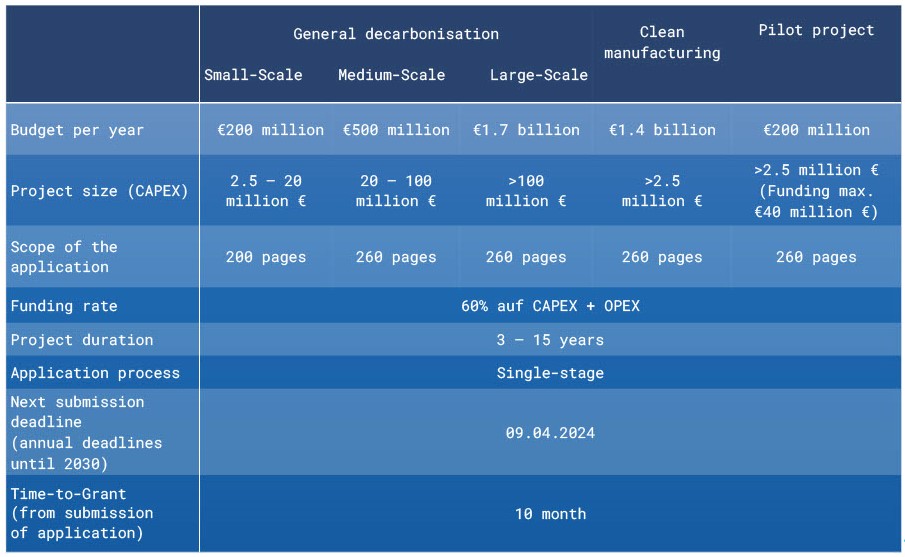- Levin Winzinger
- 19.11.25
- 3 min
- Recycling, Success factor sustainability
Your contact person
Rupert Reiter
+++ Innovation Fund blog series (part 2) +++ With the Innovation Fund, the EU aims to invest in new technologies that significantly push forward the reduction of greenhouse gas emissions. With a budget of at least €40 billion between 2020 and 2030, the funding instrument is one of the world's largest support programmes for demonstrating innovative low-carbon technologies.
Are you ready to contribute to a climate-neutral future with your innovation? The Innovation Fund offers millions in funding for innovation projects. But who is eligible to apply and what is funded? Find answers to these questions in our overview.
+++ Our Innovation Fund blog series +++
|
The EU has set itself the ambitious goal of becoming climate neutral by 2050. The EU Innovation Fund was designed with the aim of bringing highly innovative technologies and industrial solutions for decarbonising Europe to the market. The budget comes from the EU Emissions Trading Scheme (ETS). It aims to support technologies in all Member States to accelerate the transition to a climate-neutral, competitive and innovative EU economy.
With a funding rate of 60%, the EU Commission supports companies to invest in clean energy and industry to boost economic growth, create sustainable local jobs and strengthen European technology leadership on a global scale.
Companies that are directly responsible for the implementation and management of the innovation project are eligible to apply. Projects are possible on a stand-alone basis or in small consortia. Project implementation must take place in EU ETS member states: EU Member States, Liechtenstein, Norway or Iceland.
Cross-sectoral projects and projects in the circular economy are also welcome.
The Innovation Fund in the development process:

The Innovation Fund is not a research and development project, but a demonstration project with a duration of between 3 and 15 years. The focus is on the first industrial implementation of innovative low-carbon technologies that are not yet commercially available.
A project example could look something like this:
Your company has developed a novel hydrogen-powered plant that is now to be built on an industrial scale. The project is similar to an investment project as you would present it to the management board or potential investors. Since the technology is highly innovative, but also involves a certain financial risk, your company or pilot customer is not prepared to bear the entire project costs itself. This is where the Innovation Fund would come into play. If the EU is convinced by your idea, it will contribute to 60% of the costs to guarantee project implementation.
Funding is available for investments in low-carbon technologies (CAPEX), but also for the costs of operating these technologies (OPEX).
Applications that are rejected but have met certain minimum requirements can receive additional support in project development.
A particularity of the Innovation Fund is that the grants are not considered state aid and can be combined with funds from other funding programmes.
Small-scale projects are also a good alternative in the Innovation Fund to other programmes such as LIFE or the EIC Accelerator, where the requirement for the degree of innovation is also very high. The Innovation Fund programme is particularly well suited for the first commercial application of a new climate-friendly technology.
Would you like to find out more about the opportunities in the Innovation Fund or find out whether your project idea fits into this funding programme? Get in touch with us. We will be happy to check this for you free of charge. Alternatively, we will check your idea for other research and innovation programmes, as we are also very familiar with the national and European funding landscape. Here you can find more information about our funding advice.
Regardless of whether it is a large-scale or a small-scale project, the extent of an application to the Innovation Fund should not be underestimated: between 170 up to 320 pages including all mandatory annexes (proposal, business plan, financial plan, feasibility study, implementation plan, CO2 balance, etc.) must be submitted by the deadline. The preparation of the application documents involves many preliminary working steps, analyses and calculations. It may also be necessary to carry out an LCA analysis in advance (Example: LCA in battery recycling). This costs time and money.
Key facts about the application process are summarised in the following table:

At EurA, we have more than 20 years of experience in applying for public funding for innovation projects. In the past, we have acquired more than 150 million euros in EU funding in various programmes for over 80 of our clients. In all the steps leading to your Innovation Fund application, you will benefit from our many years of experience and expertise. You can concentrate on your project and we ensure that your application meets the reviewers' expectations. We support you from the very beginning: from the conception of your innovation project, through the preparation of the application documents, to project monitoring and accounting for the funding - and beyond. We accompany you throughout the entire innovation process.
Are you convinced of your technology and its potential for climate protection? Seize the opportunity to apply for a funding project in the Innovation Fund. This will increase your chances of raising your company's visibility at the European level and successfully mastering market entry.
Text: Elpiniki Lamproglou, Stefan Durm

Your contact person
Rupert Reiter
EurA AG
T- 079619256-0Max-Eyth-Straße 2
73479 Ellwangen
info@eura-ag.com